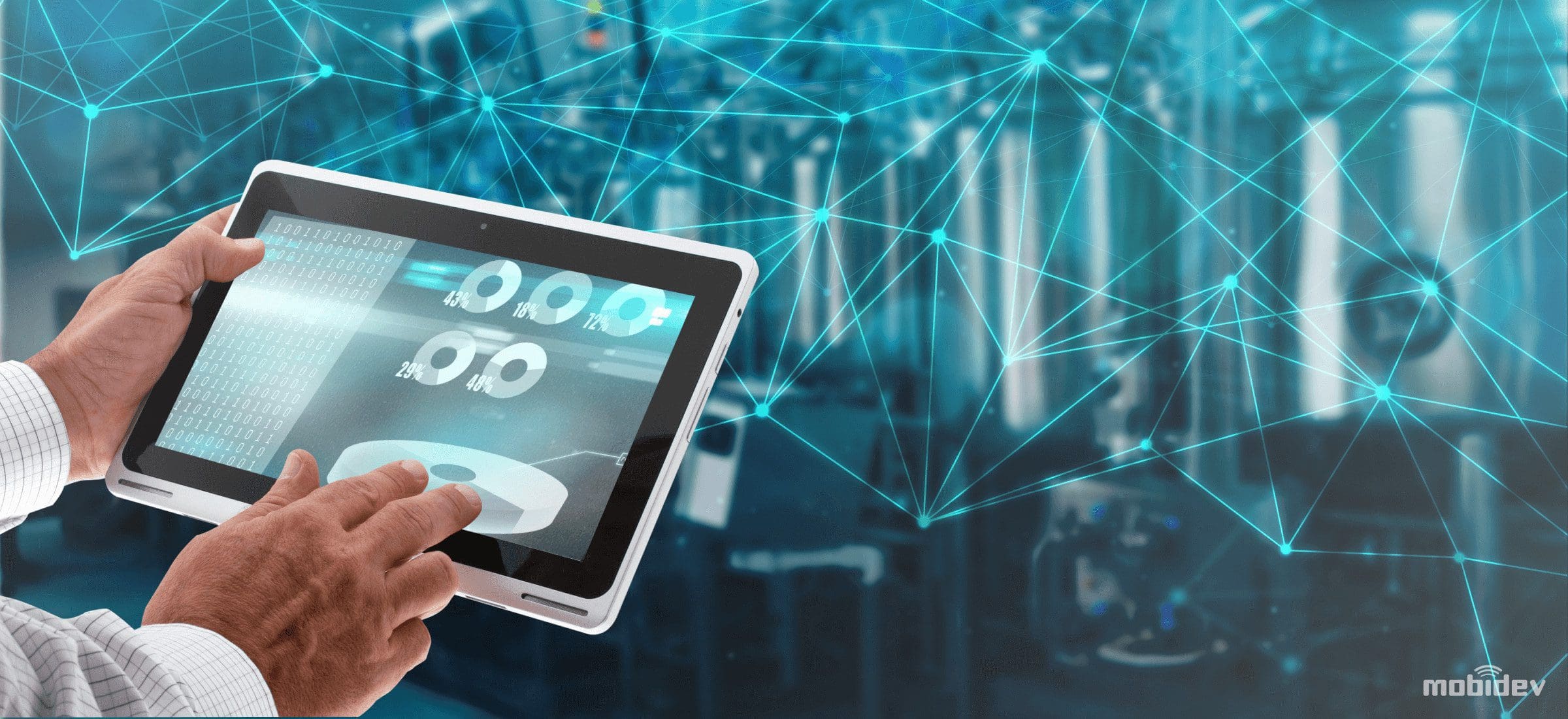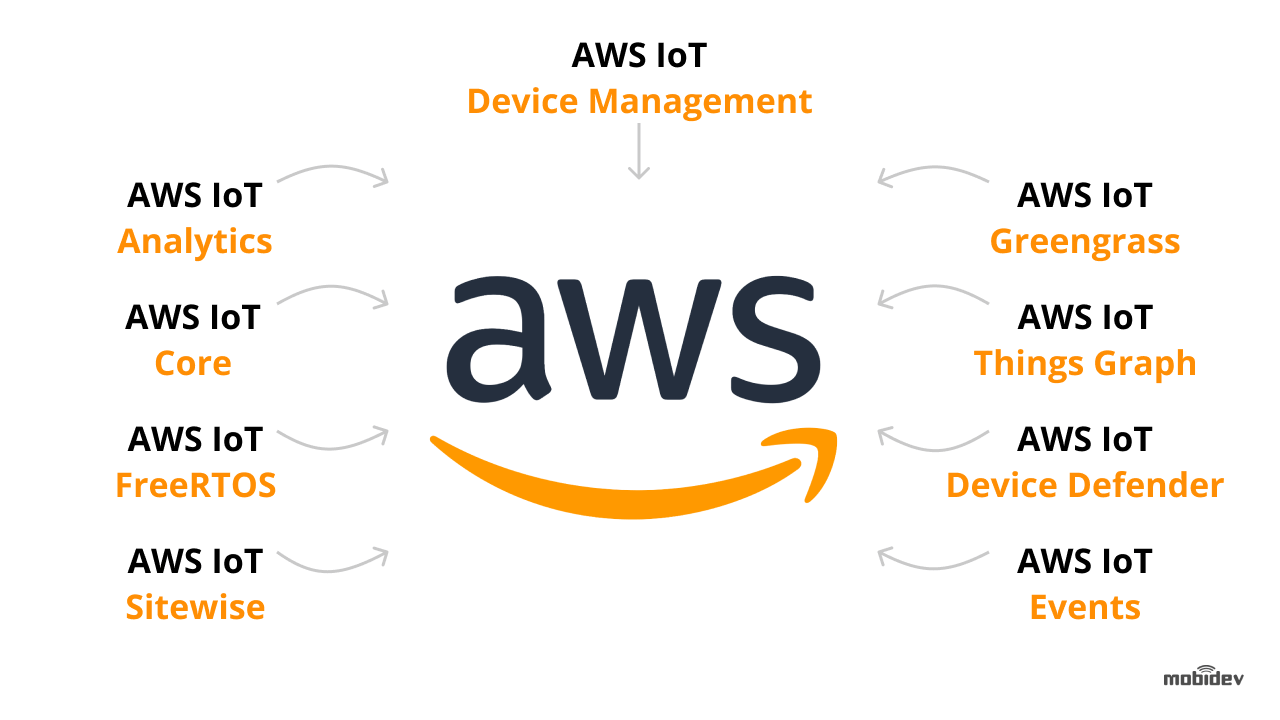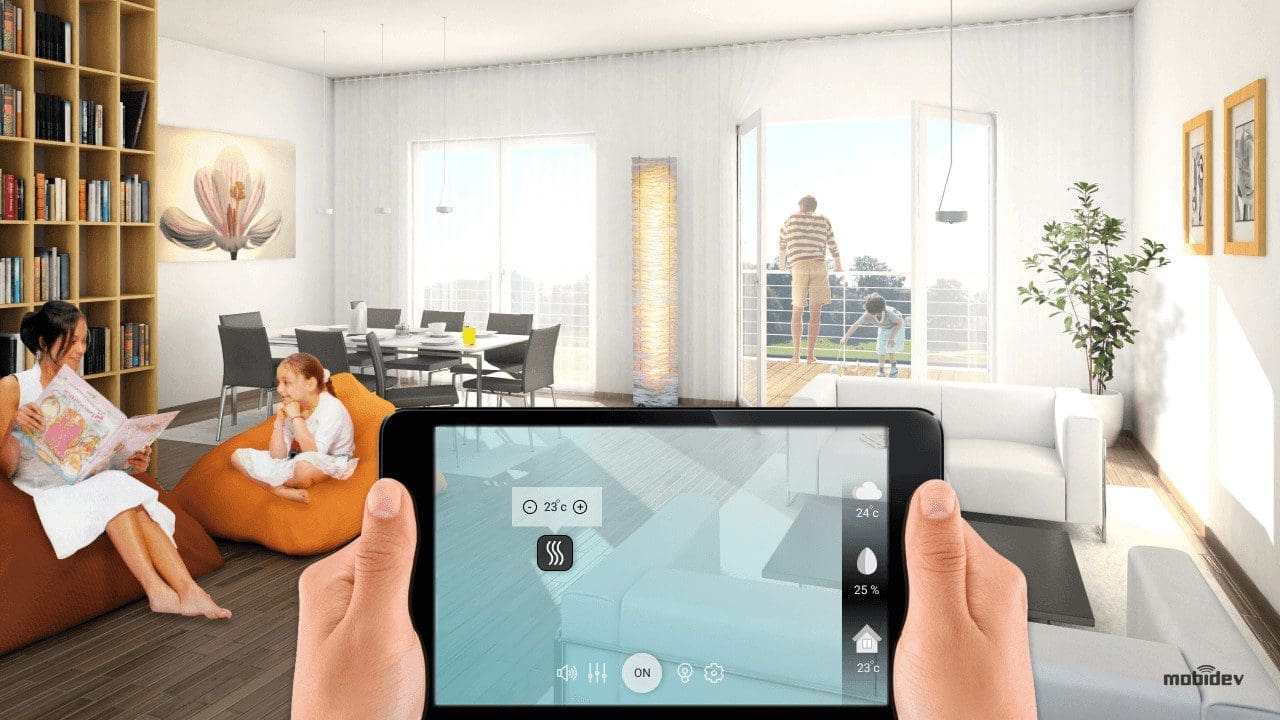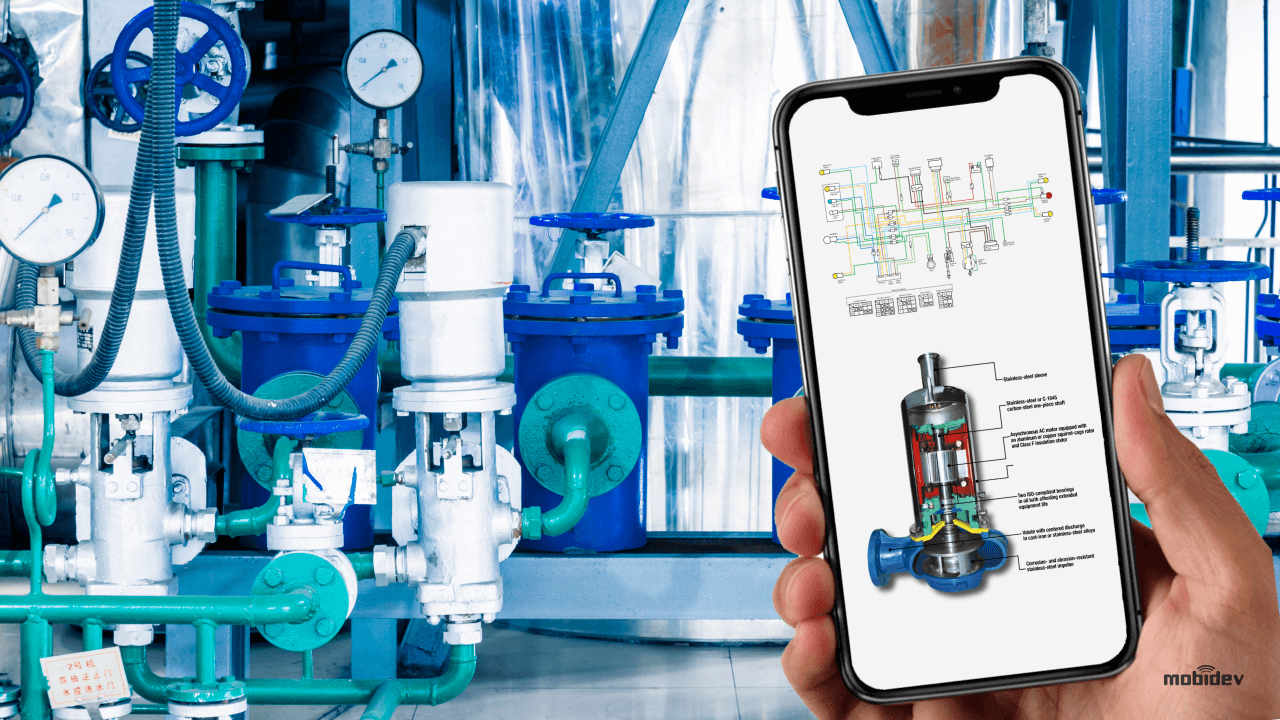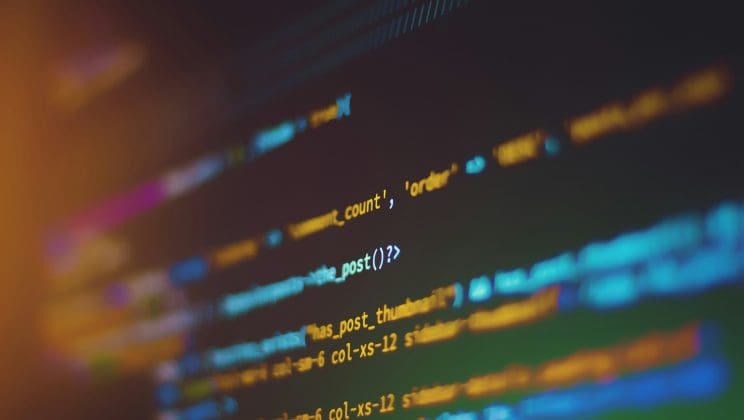With a sphere as disparate as the Internet of Things—and with products ranging from simple beacons to complex industrial equipment and smart home systems—the advent of platforms to streamline development was only a question of time.
The most notable of these platforms is Amazon Web Services IoT. Its services empower developers to speed up the development process and raise the bar of stability and reliability. Some of our own cases show that months of work on custom server modules can be reduced to a couple of weeks or even several days.
Moreover, the flexibility of AWS IoT allows our developers to establish seamless integration of IoT products within large ecosystems, which may comprise a diversity of custom elements such as web services, analytic systems based on Data Science or, say, Alexa Skills.
What is AWS IoT?
Amazon Web Services Internet of Things is a platform that offers device software, control services, and data services for IoT development, maintenance, and data processing. Introduced in 2015 with the goal of providing a one-stop shop for IoT development needs, AWS IoT has already made huge waves in the business world. Backed by the reliability and performance of the AWS platform combined with the power of IoT data gathering, AWS IoT makes a long list of convincing arguments for integrating it with your own IoT project.
AWS IoT services are more than just a connection to AWS – it’s an entire platform intended to streamline creation of industrial, commercial, and consumer solutions. Amazon’s platform addresses all the concerns for IoT products and services, from programming and data processing, to security and maintenance. This focus on creating an entire package for the IoT environment lets companies spend more time designing products, rather than worrying about expensive infrastructure or home-brewed development solutions.
Amazon is already a leader in IoT development services, with a recent survey by the Eclipse Foundation reporting as much as 50% market share. Possessing an impressive array of customers using the platform, including the likes of NASA, Honeywell, and GE, it’s clear that AWS IoT has something the rapidly growing IoT world is interested in.
AWS IoT attracts both emerging companies and larger enterprises with usability, flexibility, and scalability. Meanwhile, Amazon’s commitment to new startups and creative design can give developers the confidence to take their first steps into the IoT world, or continue on the IoT path with a renewed vigor.
What services are included in the AWS IoT platform?
- AWS IoT Core: The heart and soul of the AWS IoT platform, IoT Core encompasses the backbone of Amazon’s IoT offering. A multi-faceted approach that links several independent systems working together, IoT Core brings many of the services listed below together to create an entire IoT development and maintenance package. It’s the bridge between your devices and the greater AWS platform.
- AWS IoT Device Defender: A service used for device identification, authentication, and authorization, as well as data encryption. It takes a secure approach to protect devices from tampering or misuse. It can be set to trigger warnings and report suspicious behavior, such as active DDoS attacks originating from the device.
- AWS IoT Sitewise: A custom-tailored tool for industrial applications. It allows data to be collected from equipment and sent off for organization and processing. A secure gateway located on-site collects stored data from industrial equipment and sends it to AWS servers.
- Amazon FreeRTOS: A low-impact operating system designed for micro-controllers, FreeRTOS is Amazon’s answer to the demand for secure, low-power communication with devices. Entirely open-source and available at no charge, FreeRTOS is designed specifically to provide all the necessary software tools to easily connect IoT devices to the AWS IoT Core or AWS IoT Greengrass.
- AWS IoT Greengrass: If FreeRTOS is an operating system for micro-controllers, IoT Greengrass can be thought of as a service for a greater network of managed IoT devices. Using this service, connected devices can operate even with loss of Internet connection, acting as an extension of the AWS Cloud itself.
- AWS IoT Analytics: A comprehensive service that handles the processing and use of massive volumes of data. This service takes enormous, garbled, and unstructured data sets and help businesses filter, transform, analyze and even visualize it into something useful. Almost infinitely scalable, Amazon’s IoT Analytics can handle data from millions of devices without the need for expensive infrastructure.
- AWS IoT Device Management: Intended to handle IoT device deployments in projects of any levels, IoT Device Management organizes thousands or even millions of connected IoT devices using a single system, allowing businesses to monitor and provide maintenance from a single location.
- AWS IoT Things Graph: An asset relationship tool for IoT devices. IoT Things Graph makes visualizing and connecting the operation of different IoT devices from a variety of vendors into one cohesive image.
- AWS IoT Events: This service gives a simple way to detect an event and respond to it with familiar if-then-else statements. As an example, AWS IoT Events could be used to respond to temperature changes from a thermal sensor and give instructions to change the speed of a nearby cooling fan.
Benefits of AWS IoT for business app development
Amazon’s approach to IoT development aims to target every market. From a one-man garage-based operation attempting to build a smarter toaster to a sprawling multinational corporation attempting to cut costs and improve efficiency in their communication network, the AWS IoT platform has the tools necessary for smart devices to not only succeed, but to excel at their functions.
Easy-to-use software and simple coding empower new creators to start flexing their IoT muscles. Before AWS IoT came around, building a smart toaster would require huge amounts of development and prep-time. In order for the toaster to interact with an online grocery service and order more bread, the designer would need to create a way to place an order with the grocery service. With AWS IoT and Lambda functions, that same process can be setup in a fraction of the time. Likewise, when the smart toaster notifies the hungry bread-toaster of their completed breakfast via text message, that too would have needed its own custom implementation for an SMS service. Once again, AWS IoT makes this a near-trivial design scenario.
Moving to a more scalable example, industrial IoT was long considered a massive task involving huge investments to create processing infrastructure for collected data. In order for industrial IoT to be truly useful, it requires real analysis and processing of information gathered by devices and sensors, a task that demanded large server farms with the computing power and storage to carry the massive amounts of data often used at scale. Amazon’s IoT Analytics removes the infrastructure demands entirely, giving businesses an Infrastructure-as-a-Service (IaaS) solution for IoT data processing and analysis.
The icing on the IoT-flavored cake is a strong security offering to protect consumers and businesses from costly data breaches or dangerous intrusions. IoT devices are particularly vulnerable to tampering when left unsecured, and Amazon’s commitment to iron-clad device security through encryption, authentication, and auditing gives businesses peace of mind that their IoT deployments won’t become a costly security mistake.
Business use cases
AWS IoT already garners business from corporations around the world, and emergence of use cases for IoT-powered business don’t seem to be slowing down anytime soon. Smart homes, industrial applications, predictive maintenance for transportation or infrastructure assets, and environmental monitoring are just a few of the sectors reaping the rewards of AWS IoT deployments.
Smart Home
One of the fastest-growing IoT markets for consumer use, smart home development is projected to nearly double in revenue over the next 5 years, from $76.6 billion in 2018 to $151.4 billion by 2024. You probably don’t have to look farther than your living room to see why. Nearly every new consumer product these days is trying to integrate IoT functionality in some way. Such products as smart fridges, smart TV, and personal assistants are finding their way into consumer’s homes across the globe.
LG had already constructed a staggering amount of infrastructure to support the collected data from tens of millions of devices, but in 2016 the company migrated to the AWS platform. Amazon provided the scalable infrastructure LG needed to run detailed analytics on the information they were amassing – a need no other cloud service provider could meet.
Industrial applications
Technology has continued to drive forward industrial manufacturing at a breakneck pace, and IoT deployments are starting to lead the charge in manufacturing efficiency. IoT offers a revolutionary new way to look at the manufacturing process as a whole, generating cost savings in places previously thought impossible.
European industrial behemoth Siemens took a deep look at the combination of IoT and cloud computing in 2017. Using IoT sensors and equipment, Siemens had planned to closely monitor the overall equipment efficiency (OEE) of their manufacturing plants. Originally the department behind this new process had planned to manually record and process each set of data by hand.
Instead, Siemens decided to host their IoT operating system, Mindsphere, on the AWS platform. Mindsphere allowed the company to gather efficiency data from their machines on a global scale, creating transparency for their manufacturing lines and giving real financial data on equipment use. By combining this data with AWS, Siemens could now analyze this information in near real time and find improvements to their manufacturing process in hundreds of plants worldwide.
The Mindsphere and AWS rollout is already giving Siemens real results. The team behind the data aims to eventually increase their overall equipment efficiency by 40% in the first year of use. For a multinational manufacturing operation, that could potentially mean billions of dollars in increased revenue.
Predictive maintenance
When it comes to asset management, predictive maintenance is almost always less costly than responsive maintenance. Equipment being out of order for any amount of time is never a good thing, and replacements can often be more costly than simply keeping up on parts that are likely to fail.
IoT devices, combined with analytics and machine learning, can spot patterns in equipment failures and improve the life cycle of assets in use across a wide range of sectors. Technology, infrastructure, transportation – all of these can see huge benefits from intelligent predictive maintenance enabled by intelligent IoT devices and analytics.
CAF, a train and railway system manufacturer headquartered in Spain, is using predictive maintenance to improve the life cycle of their trains. By using data collected from sensors spread throughout their trains, they can better maintain their trains currently in operation.
This kind of predictive maintenance can be used in many applications. The city of Newport, located in Great Britain, uses the AWS IoT platform to monitor thousands of sensors across the city. The city has used IoT devices to better predict and prevent flood damage from the nearby estuary. This has led directly to huge cost savings.
Environmental monitoring systems
Another sector with wide-reaching benefits, environmental monitoring using IoT devices has applications for everything from agriculture to data center management. Using small sensors to gather data from the surrounding area, IoT micro-devices can improve water quality, maximize plant growth, operating efficiency, or even help prevent natural disasters.
Further steps have yet to be taken by businesses that will build and deploy Internet of Things solutions based on the continuously evolving Amazon offerings. If your own business is related to the world of IoT, your ideas are about to be taken to the next level of functionality and streamlined implementation.
Video demo: Smart Mirror based on AWS IoT and Amazon Alexa
Now as for our actual experience with the subject matter, check this video demo of our internal project that involves AWS IoT, Amazon’s Alexa voice assistant, and Data Science in a single IoT product for smart homes and offices.
On one of our projects, we needed a server module that would connect IoT devices, define the event response behavior within the system, and cover the issues of security. The option of writing a rather large custom module from scratch would take about 3 months of work. As opposed to this, AWS Device Defender, together with Action Rules, meant covering all of these needs within a span of several days, as well as enabling easy and quick testing of the entire system.
